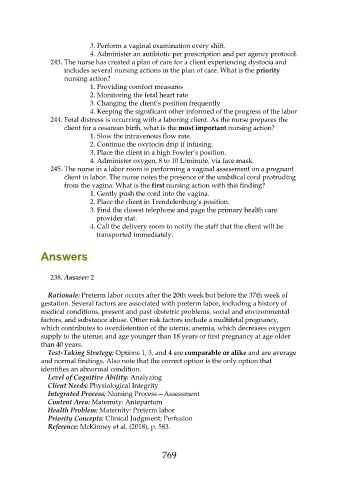Page 769 - Saunders Comprehensive Review For NCLEX-RN
P. 769
3. Perform a vaginal examination every shift.
4. Administer an antibiotic per prescription and per agency protocol.
243. The nurse has created a plan of care for a client experiencing dystocia and
includes several nursing actions in the plan of care. What is the priority
nursing action?
1. Providing comfort measures
2. Monitoring the fetal heart rate
3. Changing the client’s position frequently
4. Keeping the significant other informed of the progress of the labor
244. Fetal distress is occurring with a laboring client. As the nurse prepares the
client for a cesarean birth, what is the most important nursing action?
1. Slow the intravenous flow rate.
2. Continue the oxytocin drip if infusing.
3. Place the client in a high Fowler’s position.
4. Administer oxygen, 8 to 10 L/minute, via face mask.
245. The nurse in a labor room is performing a vaginal assessment on a pregnant
client in labor. The nurse notes the presence of the umbilical cord protruding
from the vagina. What is the first nursing action with this finding?
1. Gently push the cord into the vagina.
2. Place the client in Trendelenburg’s position.
3. Find the closest telephone and page the primary health care
provider stat.
4. Call the delivery room to notify the staff that the client will be
transported immediately.
Answers
238. Answer: 2
Rationale: Preterm labor occurs after the 20th week but before the 37th week of
gestation. Several factors are associated with preterm labor, including a history of
medical conditions, present and past obstetric problems, social and environmental
factors, and substance abuse. Other risk factors include a multifetal pregnancy,
which contributes to overdistention of the uterus; anemia, which decreases oxygen
supply to the uterus; and age younger than 18 years or first pregnancy at age older
than 40 years.
Test-Taking Strategy: Options 1, 3, and 4 are comparable or alike and are average
and normal findings. Also note that the correct option is the only option that
identifies an abnormal condition.
Level of Cognitive Ability: Analyzing
Client Needs: Physiological Integrity
Integrated Process: Nursing Process—Assessment
Content Area: Maternity: Antepartum
Health Problem: Maternity: Preterm labor
Priority Concepts: Clinical Judgment; Perfusion
Reference: McKinney et al. (2018), p. 583.
769

